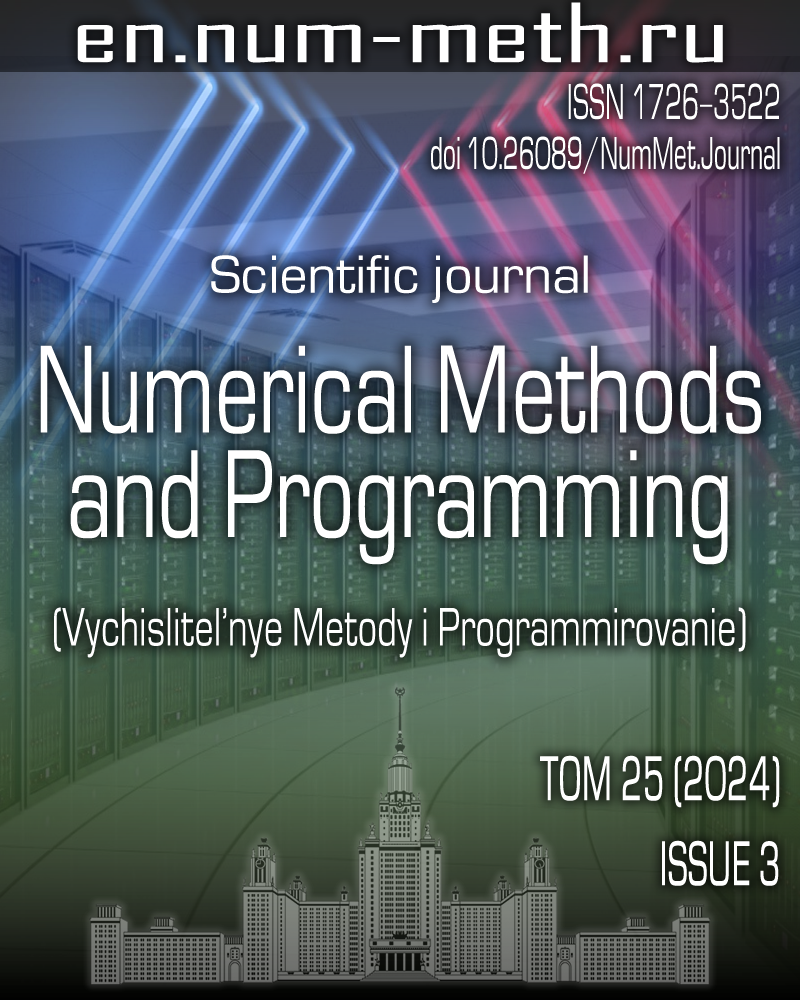DOI: https://doi.org/10.26089/NumMet.v25r319
Using natural variables to reduce algorithmic complexity of some hydraulic calculations
Keywords:
Abstract
Hydraulic calculations play an important role in a variety of engineering software in many areas, including oil and gas production. Increasing the efficiency of their numerical implementations is important for solving practical inverse problems of recovering unknown parameters of many processes. The purpose of this work is to reduce the algorithmic the complexity of calculating the time-varying pressure drop of slurry on its way through the tubing, given the slurry and the tubing parameters. Hydrostatic pressure and frictional pressure loss are being calculated as functions of specific friction pressure losses, tubing geometry and slurry pumping schedule. The correct choice of variables, introduced in this paper, allows to reduce the algorithmic complexity of the friction pressure loss to linear while hydrostatic pressure to linear-logarithmic complexity on the input data dimensions.
Published
Issue
Section
References
- A. A. Akhtyamov, G. A. Makeev, K. N. Baydyukov, et al., “Corporate Fracturing Simulator RN-GRID: from Software Development to in-Field Implementation,” Neftyanoye Khozyaistvo, No. 5, 94-97 (2018).
doi 10.24887/0028-2448-2018-5-94-97 - I. S. Zheltova, A. A. Filippov, A. V. Pestrikov, et al., “Coiled Tubing Simulation Software Development,” Neftyanoye Khozyaistvo, No. 7, 120-126 (2020).
doi 10.24887/0028-2448-2020-7-120-126 - M. J. Economides and K. G. Nolte, Reservoir Stimulation (Wiley, Chichester, 2000).
- A. V. Degovtsov, V. N. Ivanovskiy, S. A. Karelina, et al., Equipment and Technologies of Operations on Oil and Gas Wells Using Coiled Tubing (Gubkin Oil and Gas University, Moscow, 2020) [in Russian].
- A. Ya. Malkin and A. I. Isaev, Rheology: Concepts, Methods, Applications (Professiya, St. Petersburg, 2007) [in Russian].
- A. C. Barbati, J. Desroches, A. Robisson, and G. H. McKinley, “Complex Fluids and Hydraulic Fracturing,” Annu. Rev. Chem. Biomol. Eng. 7, 415-453 (2016).
doi 10.1146/annurev-chembioeng-080615-033630 - E. S. Batyrshin, R. R. Sharipov, M. G. Volkov, et al., “Rheological Features of Guar Gum Based Cross-Linked Fracturing Gels,” Neftyanoye Khozyaistvo, №. 11, 127-131 (2022).
doi 10.24887/0028-2448-2022-11-127-131 - Y. Yi, B. Lund, B. Aas, et al., “An Advanced Coiled Tubing Simulator for Calculations of Mechanical and Flow Effects; Model Advancements, and Full-Scale Verification Experiments,” in SPE/ICoTA Coiled Tubing Conference and Exhibition, Houston, USA, March 2004. Paper Number SPE-89455-MS.
doi 10.2118/89455-MS - T. D. Reed and A. A. Pilehvari, “A New Model for Laminar, Transitional, and Turbulent Flow of Drilling Muds,” in SPE Production Operations Symposium, Oklahoma, USA, March 1993. Paper Number SPE-25456-MS.
doi 10.2118/25456-MS - P. F. Osipov, Hydroaeromechanics of Drilling and Fastening Wells (Ukhta State Technical University, Ukhta, 2004) [in Russian].
- N. Makovei, Drilling Hydraulics (Nedra, Moscow, 1986) [in Russian].
- A. V. Gnoevoy, D. M. Klimov, and V. M. Chesnokov, Fundamentals of the Theory of Flows of Bingham Media (Fizmatlit, Moscow, 2004) [in Russian].
- I. E. Idel’chik, Handbook of Hydraulic Resistance (Mashinostroenie, Moscow, 1992; Begell House, Danbury, 1996).
- W. L. Wilkinson, Non-Newtonian Liquids: Fluid Mechanics, Mixing and Heat Transfer (Pergamon, London, 1960; Mir, Moscow, 1964).
- S. G. Kandlikar, S. Garimella, D. Li, et al., Heat Transfer and Fluid Flow in Minichannels and Microchannels (Elsevier, Amsterdam, 2014).
doi 10.1016/B978-0-08-044527-4.X5000-2 - V. I. Klimanov and K. N. Baidyukov, “Constructing Maps of Hydraulic Fracturing Fluid According to Downhole Pressure Gauges of a Horizontal Well of Complex Design,” Neftyanoye Khozyaistvo: Scientific and Technical Materials Conference: Electronic Version (2020).
http://new.oil-industry.ru/SD_Prezent/2020/10/01-32(Cited June 11, 2024). - S. Shah, Y. Zhou, M. Bailey, and J. Hernandez, “Correlations to Predict Frictional Pressure Loss of Hydraulic-Fracturing Slurry in Coiled Tubing,” SPE Prod. & Oper. 24 (03), 381-395 (2009).
doi 10.2118/104253-PA - R. G. Keck, W. L. Nehmer, and G. S. Strumolo, “A New Method for Predicting Friction Pressures and Rheology of Proppant-Laden Fracturing Fluids,” SPE Prod. Eng. 7 (01), 21-28 (1992).
doi 10.2118/19771-PA - K. G. Nolte, “Fluid Flow Considerations in Hydraulic Fracturing,” in SPE Eastern Regional Meeting, Charleston, USA, November 1988. Paper Number SPE-18537-MS.
doi 10.2118/18537-MS - SciPy Library Technical Documentation.
https://docs.scipy.org/doc/scipy/reference/generated/scipy.signal.fftconvolve.html.(Cited June 11, 2024). - A. V. Aksakov, O. S. Borshchuk, I. S. Zheltova, et al., “Corporate Fracturing Simulator: from a Mathematical Model to the Software Development,” Neftyanoye Khozyaistvo, No. 11, 35-40 (2016).
License
Copyright (c) 2024 Г. А. Макеев

This work is licensed under a Creative Commons Attribution 4.0 International License.


